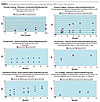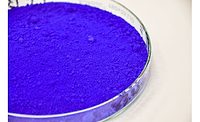
There are several possible definitions of High-Performance Pigments (HPPs) but all of them go in the same direction. A high-performance pigment is one that:1
• demonstrates high-performance properties in its intended end use;
• commands a premium price based on value-in-use and that has not yet been copied by generic producers; and
• is the right pigment for a specific use with well-defined quality criteria at optimized cost.
The superior performance of such pigments is generally related to a combination of as many key attributes/benefits as possible, e.g., uniqueness of color, ease of dispersion, durability, weather fastness, chemical resistance, processing improvements, thermal resistance and resistance to migration.
Ultramarine Blues - High-Performance Pigments?
Historically, Ultramarine Blue (PB 29) has not been considered a high-performance pigment for coatings. It is however a pigment that shows outstanding technical characteristics that could make it very appealing for paint producers in the 21st century. The most important one is the uniqueness of its reddish undertone. Such a blue color space cannot be reached by any other pigment or combination of pigments; therefore, it becomes an exceptional differentiation factor for coatings producers.Moreover, Ultramarine Blue pigment is very easy to disperse and to wet, neither migrates nor flocculates, has a high light fastness, is heat resistant, has a high solvent and alkali fastness, and does not show any metamerism. Another key feature in today’s world is its “green” profile, because it contains neither VOCs nor heavy metals in any reportable amount. On the other hand, Ultramarine Blues certainly do not have high tinting strength in comparison to organic pigments; nevertheless, they are better than other inorganic pigments such as Cobalt Blues. And it is true that Ultramarines are very transparent and do not provide opacity. But in many applications this is not a negative but rather a positive, e.g., metallic paints.
Why then has this pigment never been on the list of HPPs for coatings? The answer to this question is the historical perception industry technicians have had of the pigment’s poor weather fastness derived from its lack of acid resistance.

Correlation of Acid Resistance with Weather Fastness
Chemically Ultramarine Blue is a sodium aluminum sulpho-silicate. Due to its polysulfured composition, conventional Ultramarine Blues are not acid resistant. The pigment has a very porous structure. When Ultramarine Blue comes into contact with an acid, the acid penetrates into the pigment and breaks the polysulfur groups, damaging the 3D structure of the pigment (Figure 1). The polysulfur groups are the chromophores of the colorant. Once they have been broken there are no more chromophores available, and the reddish blue color becomes white.When is Ultramarine Blue, incorporated into a coating, potentially exposed to acids? This occurs mostly in coatings used for outdoor exposure. Exterior coatings are subjected to UV radiation, high temperature, water (both humidity and rainfall) and oxygen for long periods of time. Even when using the most stable organic binders they will progressively degrade in the presence of such conditions. This degradation might generate acid radicals that could be released from the binder and attack the Ultramarine Blue structure.
In addition, when exterior coatings are located in highly industrial areas they can be exposed to “acid-rain”. Traces of acid from the atmosphere can slowly penetrate into the paint (if it is not well protected) and/or if the system is not highly resistant to industrial atmospheres, the binder degradation can lead to a deterioration process that yields acid components. Acid rain could then lead to the decoloration of Ultramarine Blue used in paints located in such environments.
In addition, any coating made with binders of an acidic nature, i.e., PVDF, PVC plastisols, or coatings containing acidic additives, is likely to have in its composition small traces of acid components that could cause the color fading of Ultramarine Blue.

A New Generation of Silica-Encapsulated Ultramarine Blue
Therefore to make Ultramarine Blue a HPP for coatings, Nubiola Inorganic Pigments faced the challenge of developing a new manufacturing technology that protects Ultramarine Blue from being attacked by acids in order to be used in exterior coatings. From all the technologies tested, the silica-encapsulation of the pigment proved to be the most effective. This technology has already been in the market for several years, but the performance of this encapsulation was not the best one. It certainly protected Ultramarine Blue from acids to a limited extent but at the cost of other characteristics of the pigment e.g., lower tinting strength, high oil absorption and poor dispersibility, all of which limited the use of the pigment in coatings.The newly developed silica encapsulation technology overcame all the limitations of the conventional acid-resistant Ultramarine Blues from the past. This new technology delivered a new product called Nubicoat HWR (High Weather Resistance). It is based on the fact that the new technology encapsulates elemental particles and not agglomerates (Figure 2). A thinner silica layer is deposited therefore on each Ultramarine Blue particle. This results in the encapsulated pigment having a smaller average particle size as well as a narrower particle size distribution. Moreover it provides higher abrasion resistance of the protective silica coating.

All color measurements were made with a Spectrophotometer SP-88, with a D65 illuminant and a 10º angle view observant. As a conclusion of all the testing, it can be claimed that the weather fastness of the new generation of silica-encapsulated Ultramarine Blues (Nubicoat HWR) is much better than that of conventional Ultramarine Blues, similar to, or even better than, high-quality Phthalocyanine Blues, and very close to Cobalt Blues - the highly durable blue pigment benchmark.
More than two years after the launch of the breakthrough product, Nubicoat HWR has gained approvals and is regularly used by paint producers in a wide variety of applications e.g., facade paints (waterborne acrylics, styrene acrylics, silicate emulsions), interior decorative paints, powder coatings, coil coatings, coatings for plastics, bicycle and motorbike paints, and tinting systems for architectural and industrial coatings.




Report Abusive Comment